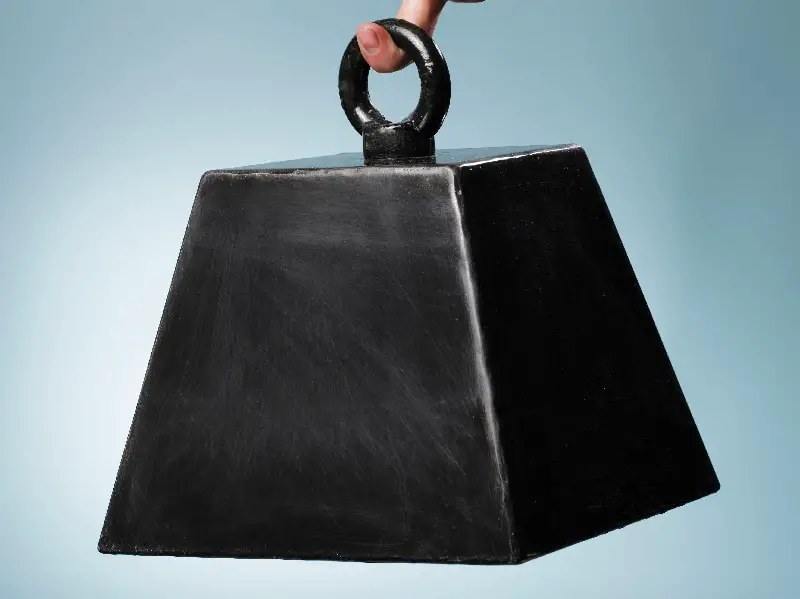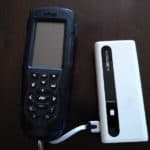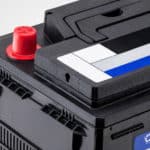Weight is a very important factor in your boat. Your boat’s performance can be greatly affected by the total weight of your gear and passengers.
Additionally, every modern boat is required to have a coastguard rating sticker with the maximum weight and passenger rating. If your boat is over the weight limit and you get checked by the coastguard, they can ticket you and have you return to the shore.
Note: most links in this article are Amazon.com Affiliate links, see Affiliate Disclosure, thank you.
How important is the weight of your electric trolling motor?
When you buy an electric trolling motor, there are many factors to consider. The most often overlooked factor is weight. Any weight on the bow of your boat greatly affects the ride and handling of your boat.
Recently, I was told to remove my anchor from the front of my boat if I was fishing in an area where I was not going to be using the anchor for fishing. I like to have the anchor on the boat for safety in case of motor failure. I have three motors on my boat, and that should be sufficient for safety.
When I took my boat out in the rough water, it was amazing. I was able to adjust my motor trim and change the ride of my boat. I was shocked at the performance difference I experienced with just sixty pounds less weight on the bow of my boat.
The point of sharing this story with you is so you can understand how important removing a small amount of weight is. So, when you look at adding or upgrading to an electric trolling motor, weight should be as important as thrust to boat size, or current system voltage.
How much does an electric trolling motor weigh?
The weight of an electric trolling motor can vary, but it does follow a pattern. The weights all go up very similarly with the thrust and voltage of the motor. This makes sense, as the motor would be heavier with more windings, and the mount should also get larger to support the motors increased output.
The only exception in this table is the Motorguide Xi5 105lb thrust model. From all the information I was able to find, the Xi5 105lb is the same weight as the 80lb thrust model.
Not included in this table is the Garmin Force trolling motor. The Garmin Force has a variable voltage of 24 or 36 volts and variable thrust in one motor. I could not confirm the weight of the Garmin motor or I would have included it in the table.
Electric trolling motor weights
| Model | Thrust | Voltage | Weight |
| Minnkota | |||
| Endura C2 | 40 | 12 | 21 |
| Edge | 70 | 24 | 58 |
| Terrova | 80 | 24 | 57 |
| Ulterra | 80 | 24 | 68 |
| Ulterra | 112 | 36 | 76 |
| Motorguide | |||
| R3 | 40 | 12 | 21 |
| Xi3 | 68 | 24 | 45 |
| Xi5 | 80 | 24 | 56 |
| Xi5 | 105 | 36 | 56 |
| Newport Vessel | |||
| Kayak Series | 36 | 12 | 20 |
| NV Series | 55 | 12 | 24 |
Here is a link to an article on this site about the best electric trolling motor for a bass boat.
How much does a marine battery weigh?
The most common deep cycle batteries range from 60 to 70 pounds. You can get a wide range of battery sizes, but a stand of about 100 amp hours is the sweet spot for electric trolling motors. For the most part, the battery weights increase with the capacity, as you can see in the table below.
I have compiled a table of a few trusted manufactures of batteries that I have personally used (other than the Gel). Many other battery manufacturers produce quality products that I didn’t include. If I were to add a few names to this list, Interstate and Exide would be the first I would add.
The table below is a marine battery weight comparison chart.
Deep cycle battery weight table
| Type | Group/Size | Amp Hours | Weight |
| Deka-EastPenn (also sold under Duracell) | |||
| Flooded | 24 | 75 | 45.5 |
| Flooded | 31 | 105 | 60 |
| AGM | 31 | 105 | 67.5 |
| Gel | 31 | 97.6 | 68.5 |
| Trojan | |||
| Flooded | 24 | 100 | 50 |
| Flooded | 30H | 105 | 66 |
| AGM | 31 | 100 | 69 |
| Gel | 31 | 108 | 70 |
| V-Max Tank | |||
| AGM | 27 | 100 | 68 |
How do I choose the proper size batteries for my electric trolling motor?
Here are links for two articles on my site about batteries for your boat
What type of battery should I use for my electric trolling motor?
How do I choose the proper size Batteries for my electric trolling motor?
Why do batteries have different weights?
The main reason batteries have different weights is the amount of lead and amount of electrolyte contained.
Batteries have lead plates inside each cell (also known as electrodes), that have positive and negative properties. Depending on the quality and the desired amp hours, the amount of lead can vary greatly from battery to battery.
Standard flooded lead-acid batteries have free-flowing liquid acid and water, also known as electrolytes. AGM batteries have electro light inside fiberglass mats, between the lead plates. Gel batteries have electro light in the state of a gel that doesn’t flow freely like traditional battery acid.
Is a charged battery heavier? Why?
I have done some reading on this question, and as it turns out, the answer is no. There are a lot of people in forums that have said batteries decreased in weight as they were discharged, but their data didn’t match any science that I have been able to find.
So here is my answer: when you discharge a battery, you are not changing the number of electrons contained in the battery. The state of the substance (electro light) in the battery doesn’t change enough to produce a measurable difference.
Here is a link to a very technical post that explains the hard science and the formulas behind this answer: https://physics.stackexchange.com/questions/34421/does-the-mass-of-a-battery-change-when-charged-discharged.
The only exception to a weight change would be in a vented lead-acid battery if water vapors escape during use. Normally this only happens during charging. Also, I recommend sealed or maintenance-free batteries in a boat.
Lightweight trolling motor batteries (for kayaks or canoes)
When you consider a battery for your canoe or kayak, there are two main points to consider. Weight, and power needs. There are lots of batteries available to consumers these days with e-commerce, so meeting these needs should be easy.
Canoes and Kayaks are lightweight boats, and because of this, they require less thrust to move them through the water. You can troll a canoe with a 36lb thrust motor at much less than 50% power. 36lb trolling motors run just over 20 pounds on average, which makes it easy to keep your boat light.
The power demands of a 36lb trolling motor are very low, so you can use a very small battery such as Mighty Max on Amazom.com. The MightyMax battery linked here is a 12 volt 55 amp hour battery that only weighs 40 pounds. My favorite characteristic of this battery is that it is an AGM valve-regulated battery. You can seal this battery in a case, or strap it down and forget it.
For boats that go under five mph, I recommend any deep cycle battery that meets your power needs, and budget because of the reduced risk of acid spills(electro light). In the case of canoes and kayaks, if you have any concern that you may flip your boat, you should stick with some form of a sealed battery.
Click here for my Beginner’s Guide to the 10 Best Lightweight Trolling Motor Batteries.
Lithium-ion trolling motor batteries
The future of all batteries could be Lithium-ion(LiFePO4). Lithium batteries have many advantages to lead-acid batteries. Some of the advantages are weight, longevity, mounting capability, depth of charge, and ground fault protection.
All of these properties are important, but the depth of charge has big implications on battery systems. Depth of charge means that you can safely run your batteries down to a 10% charge without damaging your batteries or losing any power.
Because you can safely get 90 amp-hours from a 100 amp hour battery, it is possible to run your boat on half the number of batteries. Many of these batteries have built-in charge indicators, but if not, I recommend purchasing one.
When purchasing a Lithium battery, the BMS (battery management system) is a big deal. Drop-in Lithium batteries have a built-in BMS. Make sure your battery is capable of being wired in series for 24 volt or 36 volt systems.
The only big downside of lithium batteries is the initial cost. Currently, a drop-in Lithium battery can cost four times as much as a quality AGM deep cycle battery. Manufactures justify the cost with claims of five times more charge cycles than lead-acid batteries.
Purchasing a used Lithium battery online can be a more cost-effective option. The medical industry tends to replace device batteries early for safety. Be sure to double-check the specifications before purchase.
Two options I would check out at Amazon.com are Battle Born drop-in and Ampere Time 12v100ah Lithium-ion. Always be sure to read reviews and specs before you purchase a battery.
Conclusion:
Weight in your boat is a big deal, that can affect many aspects of your boat. Affected aspects range from performance to safety. Safety is a simple matter of not overloading your boat haul’s capacity.
Performance has a lot of different aspects. One aspect would be the required thrust. Sometimes as you increase the size of equipment in your boat, the trade-off of the additional weight can cancel out the benefit of the additional motor thrust or battery amp hours.
Another aspect of additional weight could be the boat’s ride. More weight in the boat can result in less adjustment or just a rougher ride in general.
Be sure to do everything you can to balance the equipment in your boat to not have un-needed weight, to make your boating more pleasurable.




